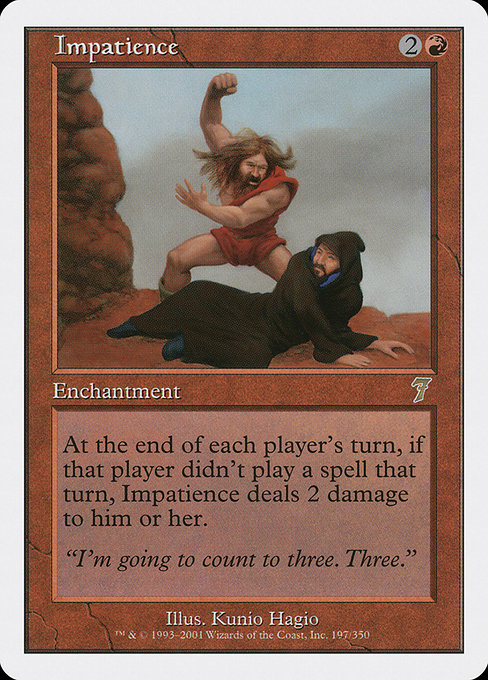
Image courtesy of Scryfall.com
Why Impatience Still Sizzles at the Table
Impatience is a deceptively simple red enchantment from Seventh Edition, a core-set relic that reminds us how social dynamics shape card popularity as much as raw power. For a modest mana investment of 2 red mana and 1 colorless (totaling 3 mana), this rare enchantment sits quietly on the battlefield until the end steps roll around. Then, at the beginning of each player's end step, if that player didn't cast a spell that turn, Impatience zaps them for 2 damage. It’s a ping with personality, a pressure point that doesn’t just say “cast spells” but reads the social rhythm of the table. 🔥🧙♂️ The card’s appeal isn’t just in its stats or its mechanism; it’s in how it invites the social contract of the game. The group’s tempo becomes part of the strategy. If you know your neighbor didn’t cast this turn, the enchantment punishes them with a reminder that a spell-free end step hurts a little more than you’d expect. In social terms, this creates a ripple of micro-decisions: do you spill a cheap spell now to dodge the damage later, or do you bide your time and risk a faceful ping when someone else’s corner of the table returns to action? It’s a friendly, noisy nudge toward engagement, a prompt to participate rather than coast. 🎲⚔️ What makes Impatience feel timeless is not just the color and cost, but the flavor that accompanies it. The flavor text—“I’m going to count to three. Three.”—sketches a character who treats the game as a countdown, a ritual of pressure and timing. Kunio Hagio’s art for this card captures the rush of red mana and the flaring intensity of a moment about to break. It’s a snapshot of a tabletop where speed and timing aren’t abstract concepts; they’re real, shared experiences that players recount at later gatherings with a grin or a groan. The card’s rarity and Seventh Edition pedigree add to its aura: it’s a veteran card that evokes a specific era in MTG history, when the game felt both timeless and freshly modern in the face of every turn sequence. 💎🎨The End Step Effect and the Social Dance
At its core, Impatience is designed to reward or punish players based on social signals. In a two-player duel, the end step becomes a focused negotiation: “Will you cast something small so you don’t burn?” In multiplayer formats, the dynamic widens. Each player is a potential target, and the table’s collective awareness—what spells were cast, who’s tapped out, who’s bluffing—creates a layer of meta-social strategy. The enchantment doesn’t require players to do anything spectacular; it thrives on the subtle choreography of passing turns, reframing the end step as a moment of table talk rather than a mere housekeeping phase. The result is a card that ages well precisely because it anchors the social side of the game in a tangible effect. 🧙♂️🧭Rarity, Nostalgia, and Community Value
As a rare from a classic core set, Impatience sits in the spectrum of cards that collectors, vintage players, and nostalgic fans prize. The Seventh Edition print marks a period when the game’s identity was still coalescing around a few iconic mechanics and a distinctive art style. Its presence in Vintage and Legacy, while not legal in every modern format, keeps it alive in community conversations about table dynamics, pacing, and the psychology of play. The card’s value isn’t only monetary; it’s a storytelling device that triggers memories of early MTG sessions—the kind where a table-full of friends discovered how a single enchantment could reshape the social contract of a game night. The combination of rarity, iconic flavor text, and an artful display by Hagio makes Impatience a touchstone for fans who love the social side of MTG as much as the mechanical side. ⚔️💎Design Lessons: From Tempo to Talk
For designers and strategists, Impatience offers a case study in how a relatively small effect can become a driver of social interaction. The card leverages time-based pressure rather than raw damage or card advantage, turning the end step into a focal point for players to consider their actions. It nudges players toward participation, crafting moments that become memorable in the retellings that define MTG culture. The lesson? Mechanics that reward or punish behavior tied to the social fabric of the table—such as who cast a spell, when they did, and how the table responds—can be incredibly effective at shaping a card’s popularity and long-tail life in the game. 🧙♂️🎲 Designers, collectors, and players who relish the storytelling dimension of MTG will find Impatience a compelling reminder: sometimes the strongest cards aren’t the ones that hit hardest on paper, but the ones that spark conversations, evoke nostalgia, and encourage players to read their table as keenly as their own hand. The art, the rarity, and the historical context of Seventh Edition all contribute to a story that keeps this enchantment alive in the memory banks of fans who still count to three with a smile. 🔥🎨If you’re looking to protect more than just your memory of classic MTG moments, check out a sleek, modern accessory to match your deck-building pace—the Slim Phone Case for iPhone 16 Glossy Lexan Ultra-thin. A small nod to the era, a big nod to practicality. Product link
Slim Phone Case for iPhone 16 Glossy Lexan Ultra-thinMore from our network
- https://crypto-acolytes.xyz/blog/post/labour-conference-did-keir-starmer-do-enough/
- https://crypto-acolytes.xyz/blog/post/unpicking-the-peace-plan-map-analysis-and-implications/
- https://crypto-acolytes.xyz/blog/post/the-psychology-behind-in-game-hoarding-and-collector-instincts/
- https://blog.digital-vault.xyz/blog/post/how-to-create-engaging-infographics-for-maximum-impact/
- https://blog.digital-vault.xyz/blog/post/luminous-blue-giant-reveals-photometric-filter-physics-across-2300-parsecs/